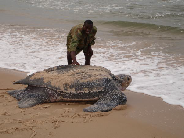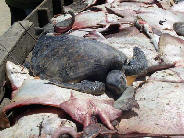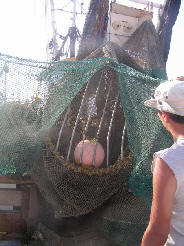EUROPEAN CETACEAN BYCATCH CAMPAIGN
"Man is but a strand in the complex web of life"
"Man is but a strand in the complex web of life"
Scientist warns of threat to last stronghold of endangered turtle
Seaturtle.org
8th March 2006
A major conservation effort, led by Dr Brendan Godley of the University of Exeter, has just got underway to help protect endangered leatherback turtles which nest in Gabon, West Africa. The region is thought to be the animals' last global stronghold, as pacific populations dwindle precariously.
It's hoped the project, to tag and track the animals, will uncover their migratory secrets and provide the basis for efforts to safeguard them. After fitting them with satellite trackers the team are using the internet to follow their journeys, which are among the longest in the animal kingdom.
Dr Brendan Godley, who is also one of the Directors of SEATURTLE.org where the tracks are hosted online, said "Pacific leatherbacks have been decimated by incidental capture at sea and overexploitation so it's vital that we protect the Atlantic population. This project is crucial to our understanding of the geographical range of the leatherback as so little is currently known about their travels. We think turtles from Gabon could be travelling as far afield as South America, Europe and even the Indian Ocean to feed on their jellyfish prey.
Once we have detailed information our tracking work will feed directly into strategies for marine protected areas in Gabon and farther afield and more sustainable fisheries.
We are just beginning to understand the importance of the leatherbacks of West Africa as a global stronghold but we need to know where they live to protect them."
The tracking data is publicly available online and is creating much interest with more than 100,000 hits from over 150 countries on the site www.seaturtle.org/tracking each month.
It's thought that globally more than 50,000 leatherback turtles are incidentally caught by fisherman trawling for other species each year. Of these, thousands are thought to die as a result. Approximately 1.4 billion hooks are cast into the world's oceans as part of industrial long-line fishing, with 37% of this fishing effort in the Atlantic. A major hotspot is found off West Africa, the focus of this study.
With fishing yields decreasing in European seas the EU has struck up a number of agreements with African nations to fish their waters. Amazingly, most EU fishing concessions don't even incorporate compulsory bycatch monitoring programmes.
Scientists from the University of Exeter's Cornwall Campus are working with a consortium of partners in Gabon (Aventures Sans Frontieres, Parcs Gabon and Wildlife Conservation Society) and the USA (Duke University, SEATURTLE.org) to try to solve the mystery of where the turtles' spend their time.
The work is supported by a range of UK and international funding bodies including the European Association of Zoos and Aquaria (EAZA) 2004/5 Shellshock Campaign www.eaza.net
Please note
Photographic images can be made available by contacting the following
UK contacts:
Dr Brendan Godley WHO CAN BE CONTACTED IN THE FIELD
email: bgodley@seaturtle.org
Rachel Hoad-Robson, Press Officer, University of Exeter
tel: + 44 (0) 1392
262062, email: Rachel.hoad-robson@exeter.ac.uk
Kevin R Buley, Shellshock, Chester Zoo
tel: +44 1244 389402,
email: k.buley@chesterzoo.co.uk
US contacts:
Stephen C. Sautner,
Assistant Director of Conservation Communications,
Wildlife Conservation Society
tel : + 1 718 220 3682, email:
ssautner@wcs.org
Dr. Michael Coyne,
Duke University
tel: + 1 919 613 8119,
mobile: + 1 301 221 9952,
email: mcoyne@seaturtle.org
The World Conservation Union (IUCN) recognizes seven species of marine turtle. The Leatherback turtle (Dermochelys coriacea) is the largest and is listed as critically endangered. Its range includes the Pacific, Indian and Atlantic Oceans and is the largest of all reptiles
Satellite tagging studies have revealed that individual turtles will swim over 11,000km during their migrations from tropical nesting beaches in the Caribbean to summer foraging grounds in European waters.
Thought to have been swimming the world's oceans for at least 110 million years, marine turtles face a number or threats around the world, including habitat destruction, accidental entanglement in fishing gear and exploitation for meat and eggs at their tropical nesting beaches.
The leatherback is a regular summer visitor to Northern European and American seas, as far north as Iceland and Canada, where it feeds on jellyfish.
Top
Seaturtle.org
8th March 2006
A major conservation effort, led by Dr Brendan Godley of the University of Exeter, has just got underway to help protect endangered leatherback turtles which nest in Gabon, West Africa. The region is thought to be the animals' last global stronghold, as pacific populations dwindle precariously.
It's hoped the project, to tag and track the animals, will uncover their migratory secrets and provide the basis for efforts to safeguard them. After fitting them with satellite trackers the team are using the internet to follow their journeys, which are among the longest in the animal kingdom.
Dr Brendan Godley, who is also one of the Directors of SEATURTLE.org where the tracks are hosted online, said "Pacific leatherbacks have been decimated by incidental capture at sea and overexploitation so it's vital that we protect the Atlantic population. This project is crucial to our understanding of the geographical range of the leatherback as so little is currently known about their travels. We think turtles from Gabon could be travelling as far afield as South America, Europe and even the Indian Ocean to feed on their jellyfish prey.
Once we have detailed information our tracking work will feed directly into strategies for marine protected areas in Gabon and farther afield and more sustainable fisheries.
We are just beginning to understand the importance of the leatherbacks of West Africa as a global stronghold but we need to know where they live to protect them."
The tracking data is publicly available online and is creating much interest with more than 100,000 hits from over 150 countries on the site www.seaturtle.org/tracking each month.
It's thought that globally more than 50,000 leatherback turtles are incidentally caught by fisherman trawling for other species each year. Of these, thousands are thought to die as a result. Approximately 1.4 billion hooks are cast into the world's oceans as part of industrial long-
With fishing yields decreasing in European seas the EU has struck up a number of agreements with African nations to fish their waters. Amazingly, most EU fishing concessions don't even incorporate compulsory bycatch monitoring programmes.
Scientists from the University of Exeter's Cornwall Campus are working with a consortium of partners in Gabon (Aventures Sans Frontieres, Parcs Gabon and Wildlife Conservation Society) and the USA (Duke University, SEATURTLE.org) to try to solve the mystery of where the turtles' spend their time.
The work is supported by a range of UK and international funding bodies including the European Association of Zoos and Aquaria (EAZA) 2004/5 Shellshock Campaign www.eaza.net
Please note
Photographic images can be made available by contacting the following
UK contacts:
Dr Brendan Godley WHO CAN BE CONTACTED IN THE FIELD
email: bgodley@seaturtle.org
Rachel Hoad-
tel: + 44 (0) 1392
262062, email: Rachel.hoad-
Kevin R Buley, Shellshock, Chester Zoo
tel: +44 1244 389402,
email: k.buley@chesterzoo.co.uk
US contacts:
Stephen C. Sautner,
Assistant Director of Conservation Communications,
Wildlife Conservation Society
tel : + 1 718 220 3682, email:
ssautner@wcs.org
Dr. Michael Coyne,
Duke University
tel: + 1 919 613 8119,
mobile: + 1 301 221 9952,
email: mcoyne@seaturtle.org
The World Conservation Union (IUCN) recognizes seven species of marine turtle. The Leatherback turtle (Dermochelys coriacea) is the largest and is listed as critically endangered. Its range includes the Pacific, Indian and Atlantic Oceans and is the largest of all reptiles
Satellite tagging studies have revealed that individual turtles will swim over 11,000km during their migrations from tropical nesting beaches in the Caribbean to summer foraging grounds in European waters.
Thought to have been swimming the world's oceans for at least 110 million years, marine turtles face a number or threats around the world, including habitat destruction, accidental entanglement in fishing gear and exploitation for meat and eggs at their tropical nesting beaches.
The leatherback is a regular summer visitor to Northern European and American seas, as far north as Iceland and Canada, where it feeds on jellyfish.
Top
One of the eco-guards from Bame beach, Gabon, poses next to a female Leatherback sea turtle as she makes her way back into the sea.

Click on image to enlarge
Photograph
©
Matthew Witt

Click on image to enlarge
Juvenile green turtle incidentally captured by artisanal fishermen targeting rays in the coast of Valizas, Rocha, Uruguay. February 2006. This is not a usual thing, as fishermen of this locality normally target another fishes far away from the green turtle feeding area.
©
Karumbé.

Click on image to enlarge
This is a photo of a Turtle Excluder Device (TED) demonstration given by UNIPESCA at Puerto Quetzal on Guatemala's Pacific coast.
All shrimp boats are fitted with TEDs and checks are done at the port. However, it is believed that the majority of turtle deaths are due to the shrimp boats. More work relating to the issue will take place next season.
©
Rachel Brittain

Click on image to enlarge
Photograph
©
Matthew Witt

Click on image to enlarge
Juvenile green turtle incidentally captured by artisanal fishermen targeting rays in the coast of Valizas, Rocha, Uruguay. February 2006. This is not a usual thing, as fishermen of this locality normally target another fishes far away from the green turtle feeding area.
©
Karumbé.

Click on image to enlarge
This is a photo of a Turtle Excluder Device (TED) demonstration given by UNIPESCA at Puerto Quetzal on Guatemala's Pacific coast.
All shrimp boats are fitted with TEDs and checks are done at the port. However, it is believed that the majority of turtle deaths are due to the shrimp boats. More work relating to the issue will take place next season.
©
Rachel Brittain